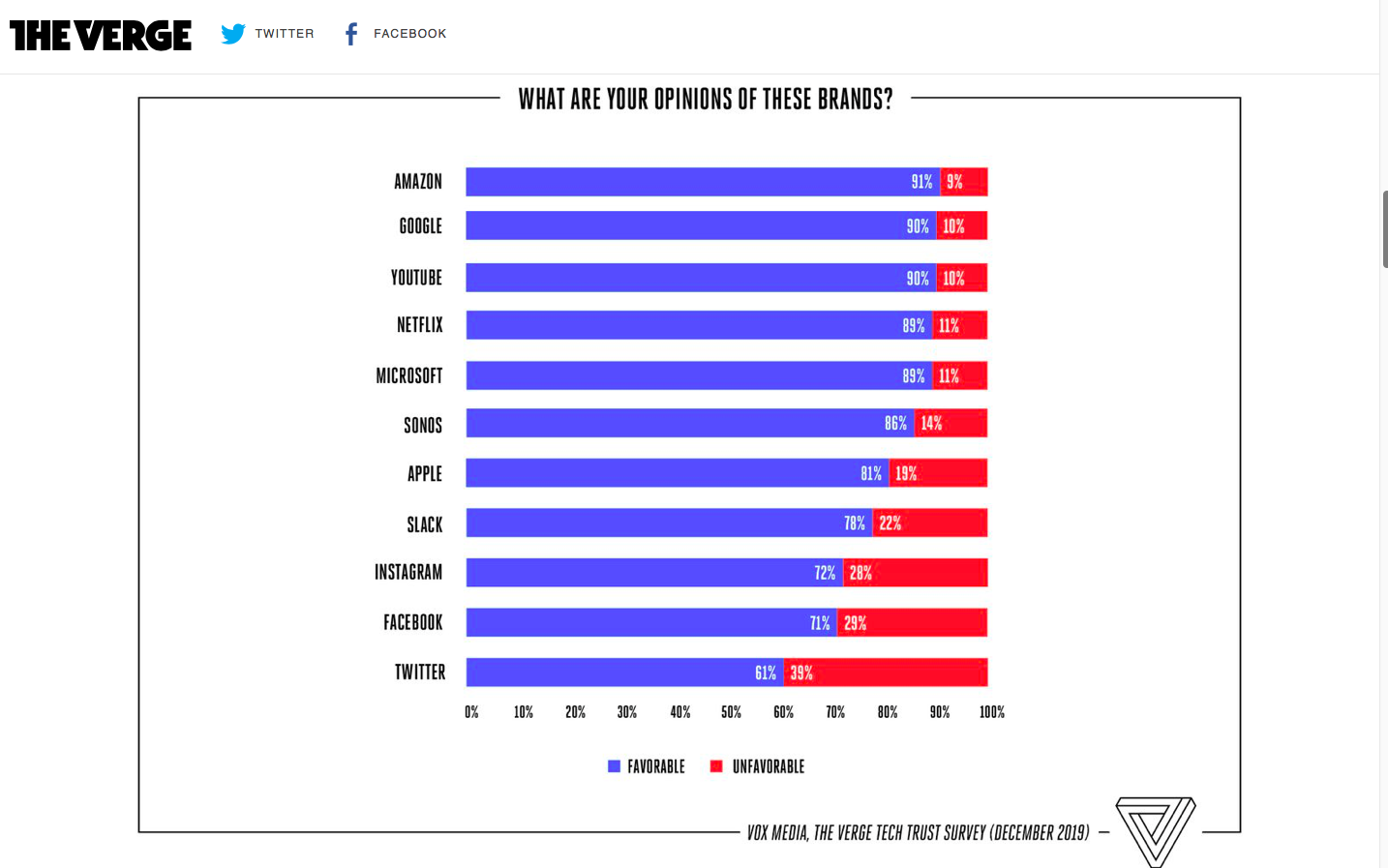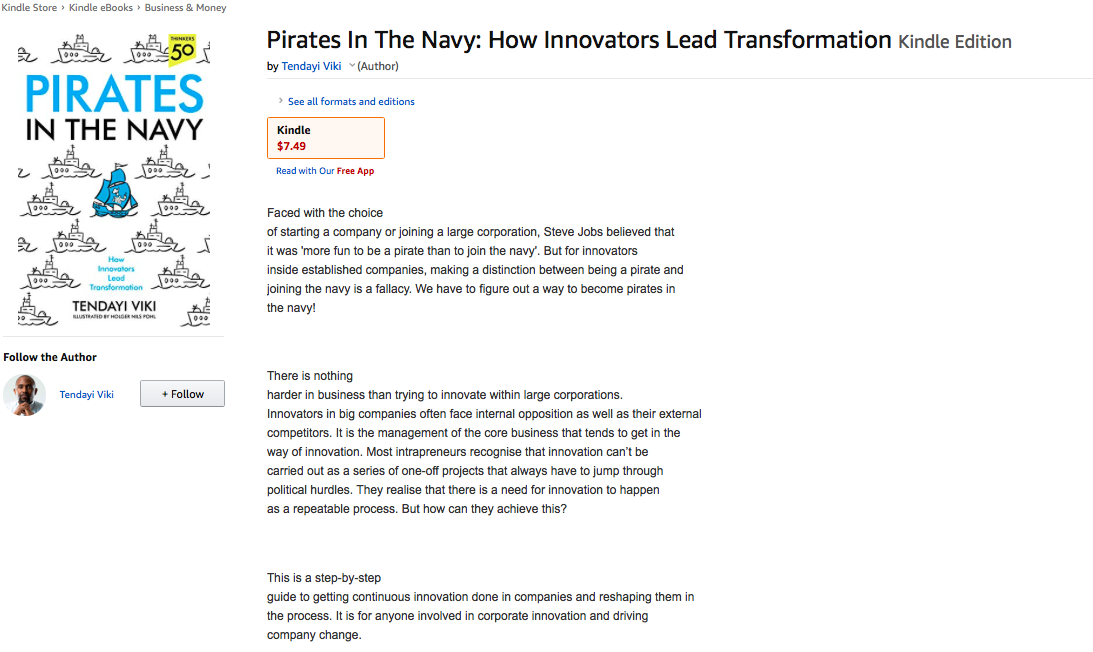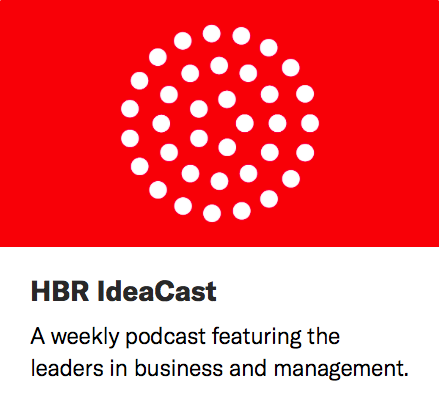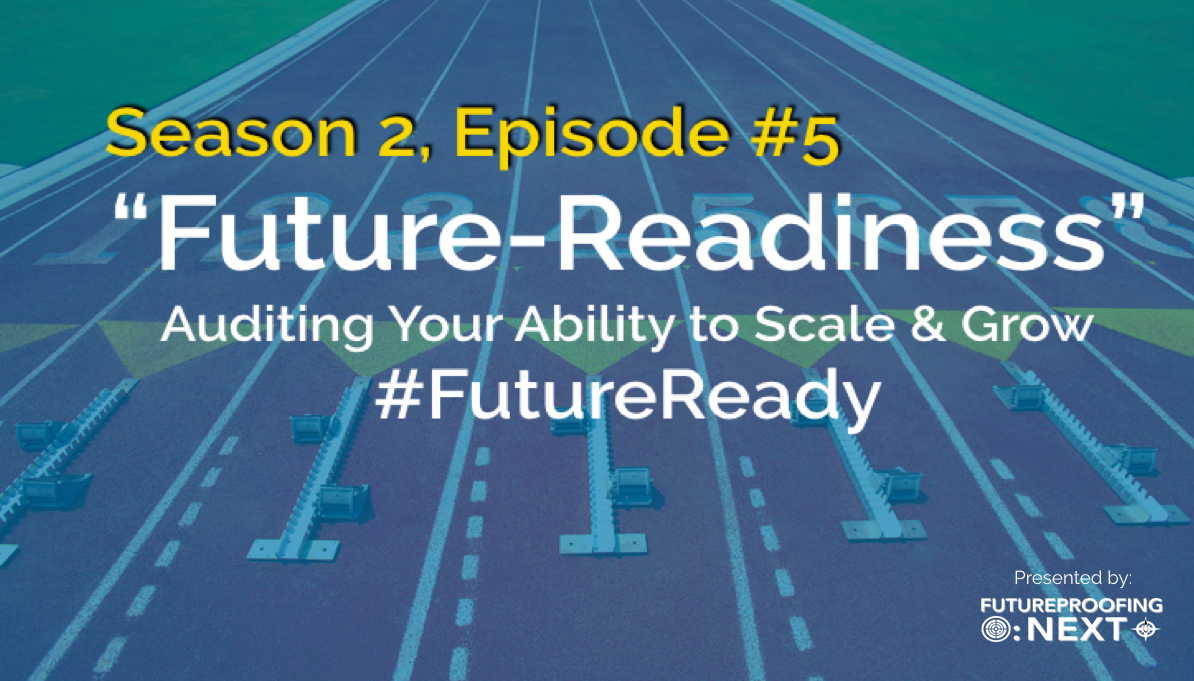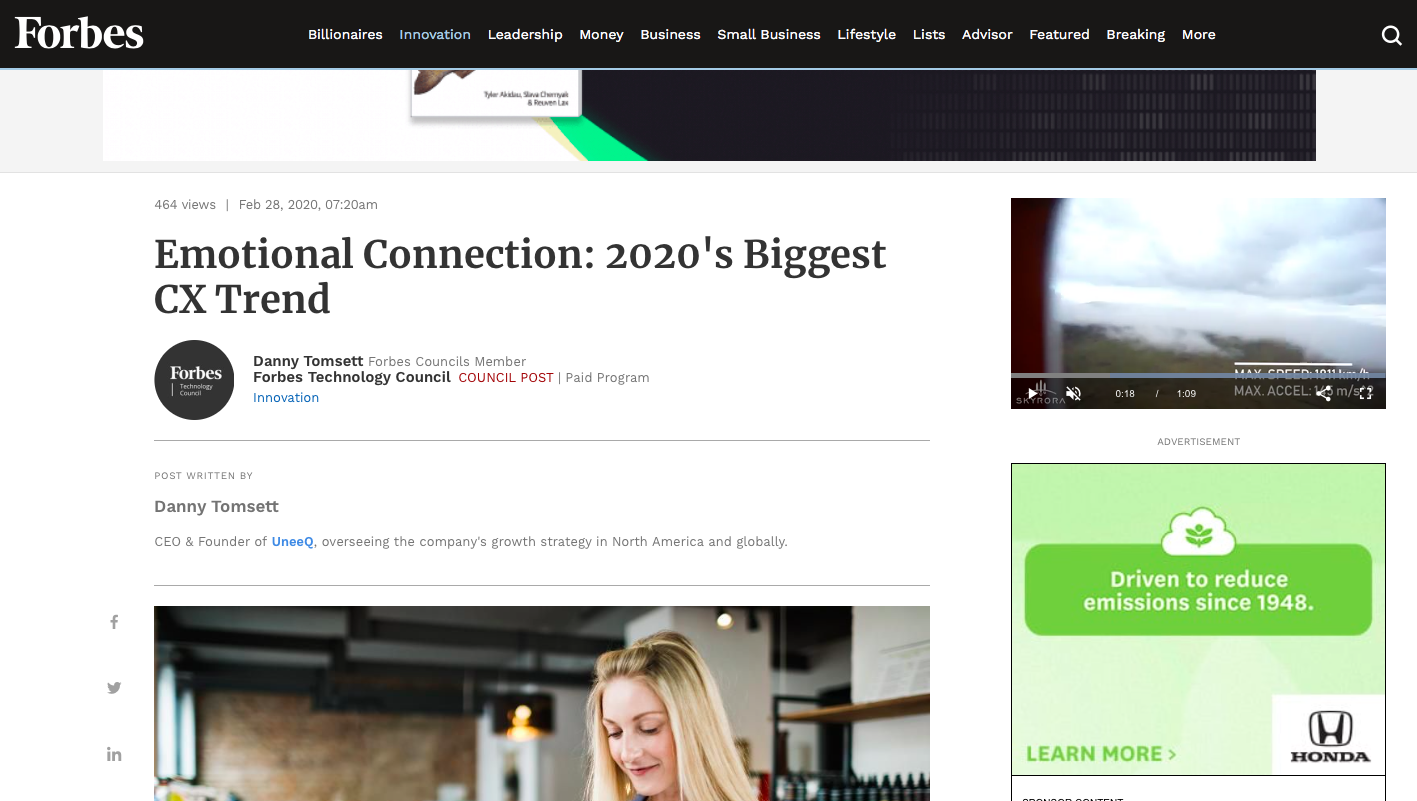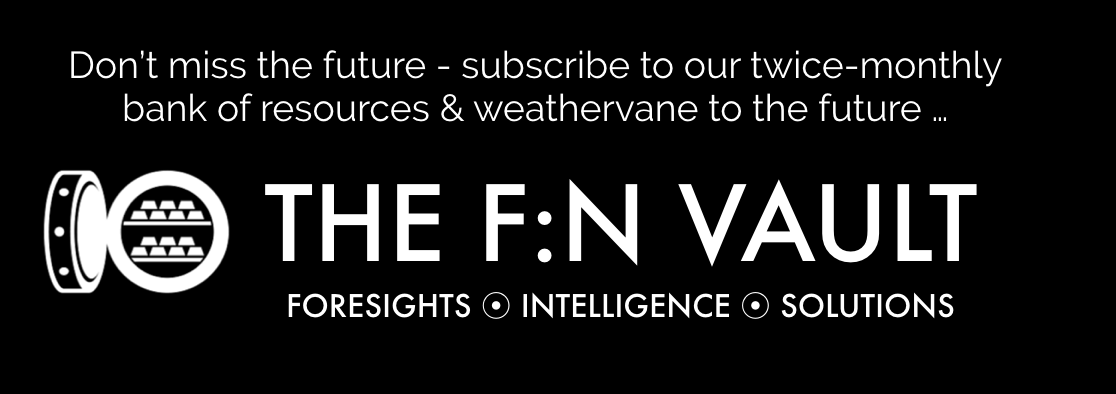The Top Three Future Foresights:
We trade articles with each other each month, these were three of our faves.
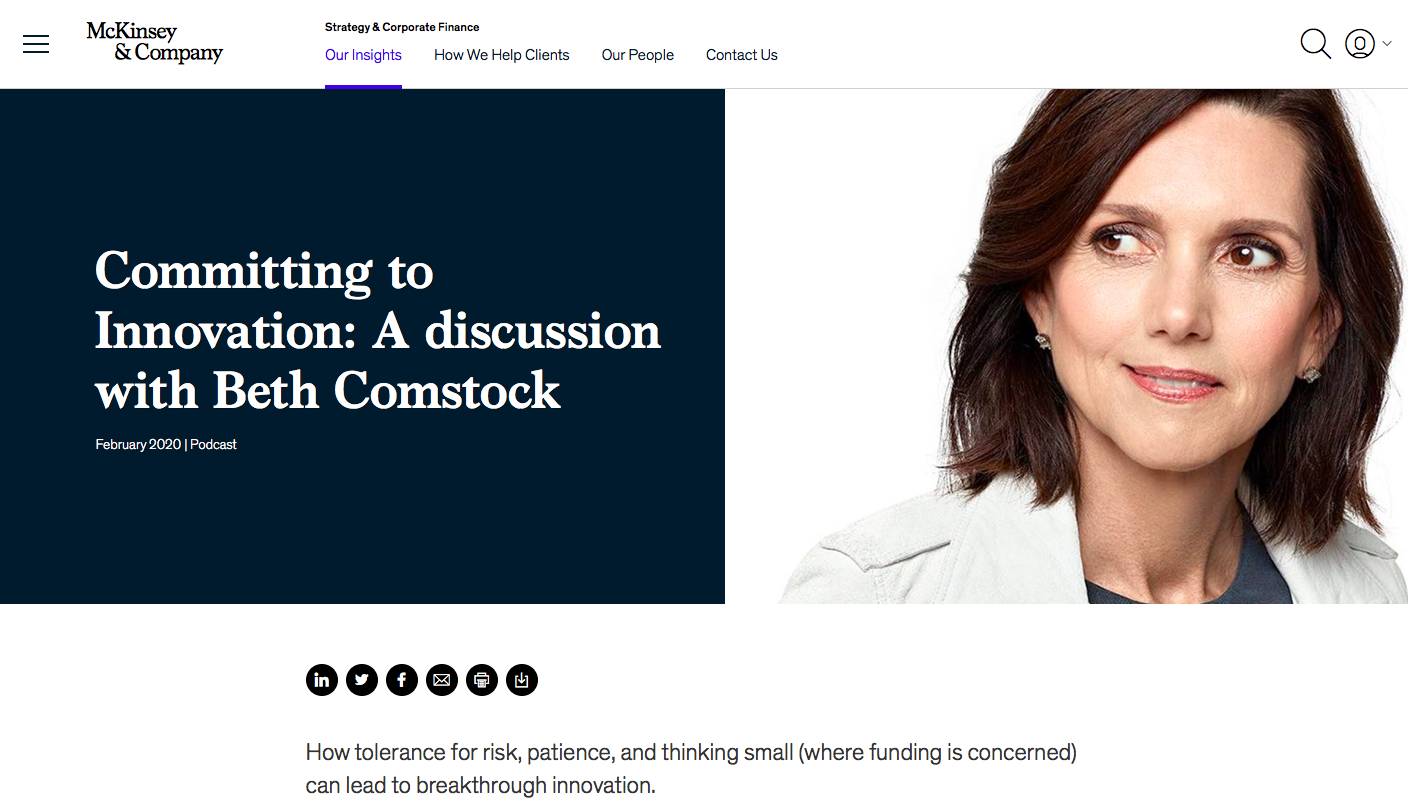
#1 Committing to innovation - A Discussion with Beth Comstock (McKinsey)
“Just having the mindset that “this is going to be messy” helps. I came to appreciate the value of having at least two lanes or speeds in the organization. You have your now lane and your next and new lanes, and you allocate capital to them differently. You have to think about measurement differently and the kind of people and ideas you’re working with. Yet most people just lump them together into a big jumble. You don’t have a profit in the next lane—sometimes you don’t even have a customer—and yet you are trying to get your P&L in shape. There is a series of things companies can start doing differently just by clearly delineating a now lane and a next lane.”
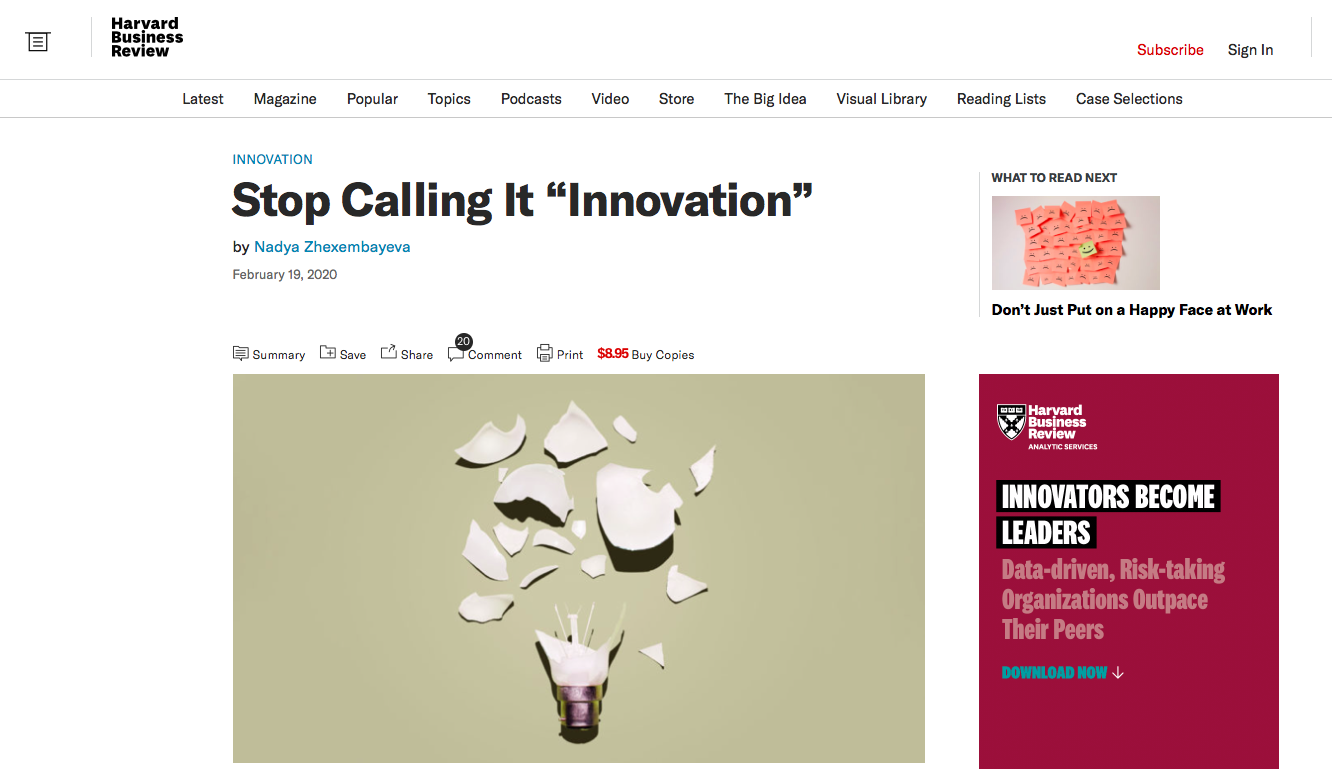
#2 Stop Calling it Innovation (HBR / Nadya Zhexembayeva )
“Innovation’s public profile is matched by its priority on the CEO’s agenda. In 2019, 55% of company leaders participating in PWC’s 22nd Annual Global CEO Survey claimed “We are not able to innovate effectively,” which placed that skill gap on top of the list. The 2020 C-Suite Challenge Report, published by the Conference Board, listed “building an innovative culture” among top-three most pressing internal concerns of 740 CEOs surveyed globally.
Since then, I’ve heard this same question posed in various ways at some point in every single project on which I’ve worked. Only a few weeks ago at the annual innovation jam of a global consumer goods company, I was told point blank: “For you people, innovation is all that. For us, it’s extra work with no results or —much worse — lost jobs.”
The data bear out these fears. A research team at the University of Toronto surveyed 1,000 American and Canadian knowledge workers (all employed and with college degrees) to assess their attitudes towards innovation. In addition to measuring “drive to innovate,” the scientist looked into things like “grit” and “openness to risk” across two countries and three age groups (under 35, 35 to 44, and over 45).
While the drive for innovation among participants varied from 14% to 28%, only two of the six different groups measured broke the 25% mark. Willingness to take risk was even more telling: at best, 19% of your company is willing, with some age groups dipping as low as 11%.”

#3 INNOVATION++ IS NOT A SPECIALIST GAME – IN PRAISE OF GENERALISTS – THE SIX TOOL FUTUREPROOFER (FUTUREPROOFING : NEXT / SEAN MOFFITT)
“Jack (or jill) of all trades” is oftentimes used in a half-demeaning way in describing many of these type of unfocused generalists, usually caveated by the additional phrase “master of none”. Apparently, it’s not just restricted to the Western world.
The Chinese muse, “周身刀,无张利 (equipped with knives all over, yet none is sharp)”. Estonians barb, ““Üheksa tehingut, kümnes – nälg. (nine trades, the tenth one — hunger)”. Greeks opine, “Πολυτεχνίτης και ερημοσπίτης (“A man of many crafts and a deserted home”)”. Globally, we generalists have a perception issue.
We need a new vernacular to describe the people that business really needs for the uncertain future:
– Renaissance men and women (talent and knowledge in many different fields of study)
– Polymaths (wide-ranging knowledge or learning)
– Decathletes (versed in 10 different sports)
– Multipotentialites (many different interests and creative pursuits in life)
– Ambi- and multi=dextrous (the ability to do more than two to three things at once)
– Factotums (a person having many diverse activities or responsibilities)
– Pantologists (taking a systematic view of all human knowledge)
– Comb-shapeds (broad based with multiple expertise areas)
– Multi-hyphenates ( a person with multiple hyphens to describe their professions e.g. singer-songwriter-producer)
We’ll add to the new lexicon by now calling them futureproofers – people who see and envision the future by having fluency in multiple lenses (the workplace, the strategy sphere, operations & technology, the marketplace, innovation and the future). We’ve attached the set of six sources of skills below that a rising tide of futureproofers is bringing to their change imperatives. Generalists see the forest through the trees and connect dots. specialists see tree (or worse still bark) and draw straight lines.
Top Change Infographics:
The world is a visual place. We sparked to these three visuals for what they contributed to futureproofing and understanding what’s next.
Top Futureproofing New Contributions:
We love connecting and collaborating with change agents, thought leaders and contributors to how we can change, transform, innovate and grow better. Here’s what we found this month:
Top Recent HBR Ideacast Episodes:
How People Succeeed by Defying Expectations with Lara Huang
Why Business Leaders Should Solve Problems Beyond Their Companies with Rosabeth Moss Kanter
How to Set Up – and Learn from Experiements with Stefan Thomke
The Other 30 Headlines:
Our other key thirty foresight headlines for the month below. All wonderful, provocative and well thought out, and covering off the full futureproofing universe. Click on the bar to expand our summary or click again to get directly to the source link.
#4 Flow by Design: A new model for business success (ZDNet / Vala Afshar)
“There is a quiet revolution going on across all our major industries, one that has been hiding in plain view until now. A small number of pioneer organizations have successfully created radically differentiated business models to their industry norms. They have done that by reinventing the way they manage their resources.These companies have also shown us that innovation at scale will require the adoption of new business models and flow-based design principles.”
#5 The Shopify angels: How the e-commerce company’s leaders are funding a new wave of ambitious startups (The Globe & Mail / Brenda Bouw)
#6 Intrepreneurs are Driving Corporate Change (Financial Times/ ELIZABETH UVIEBINENE)
#7 How to Do Strategic Planning Like a Futurist (HBR / Amy Webb)

#8 The Book that Took 9 Years To Publish - Invisible Solutions (Stephen Shapiro)
“I’ve been asked, “How long did it take to write the book?” The answer is, “It depends.” It depends on how you look at it.
December 2 – 10, 2018, I locked myself in a hotel room and started working on the book. Although I left the hotel with the first version of the manuscript, it took a lot longer to write than just one week. In fact, upon reflection, the book took nine years to write and publish. Hopefully this article will serve as inspiration (and education) to others who want to publish a book. Enjoy!”
#9 Is Disruption on Your Radar? (LinkedIn / Line Lyst )
#10 Airbnb hires Disney veteran to lead Experiences division ahead of expected public listing this year (CNBC / Rosa & Feuer)
#11 Eleven Companies That Own Nearly Every Product in the Grocery Store (Reddit)
P&G, Coca-Cola, Unilever, Pepsico, Kellogg’s, Mars, General Mills, Mondelez, Johnson & Johnson, Kraft/Heinz, Nestle
#12 Radically Advancing Product Design with State-of-the-Art Simulation and Deep Learning (My Tech Mag / Prith Banerjee )
#13 Selling Light as a Service - Philips & Turntoo (Ellen Macarthur Foundation)
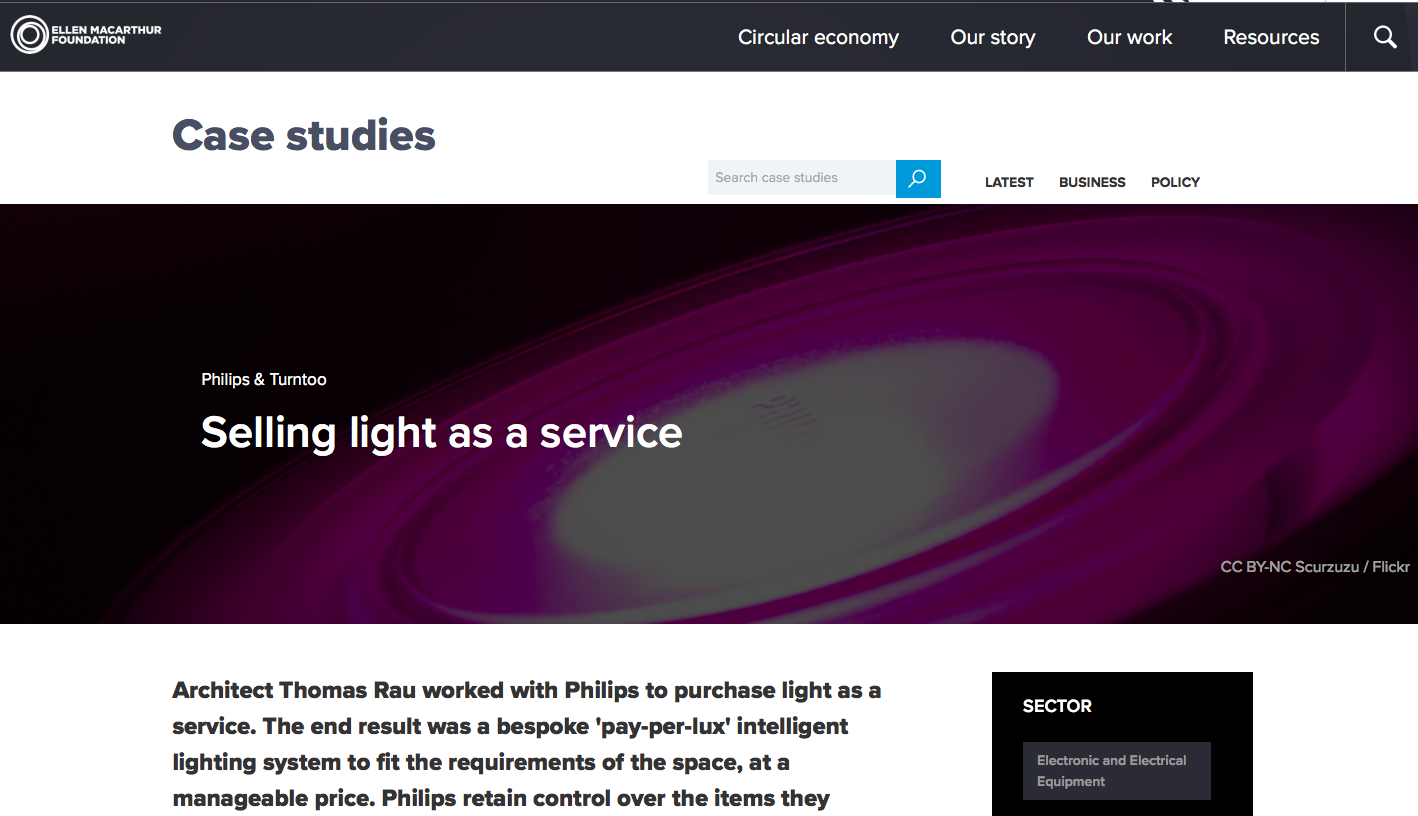
#14 The 10 Characteristics Of A Future Facing Company (forbes / TENDAYI viki)
“Running a startup is difficult. But most startup founders have it easy compared to corporate entrepreneurs trying to innovate within an established company. Innovators in large companies often find themselves surrounded by slowing moving institutions with traditional management practices. Most corporate management tools were developed during an era when the world moved at a much slower and predictable pace. Such tools are not suitable for innovators who are searching for new business models.”
#15 How To Drive Innovation In 2020 (Forbes / Teresa Spangler )
After finding those questions, you can then start to inventory your data, but not without answering additional questions:
– What is your current culture around data?
– Who are your creative thinkers in the organization?
– Where are the data experts in the company, and what core competencies do they have?
In other words, in order to answer those first two questions, you have to generate and investigate answers to nearly 100 other questions, if not more. Gaining the answers to all of these questions will allow you to build a landscape for possible ideas — on a scale of minimal risk to disruptive, high-risk ideas. You will also be able to outline the success criteria for each idea.
#16 These are the Most Innovative Economies in the World (World Economic Forum)
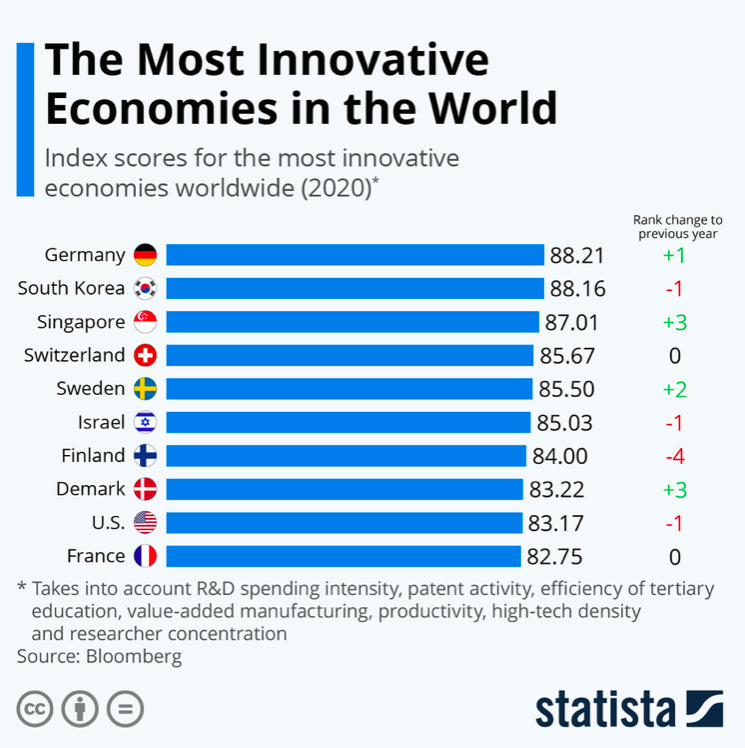
#17 The Verge 2020 Tech Survey (The Verge)
More importantly, Americans generally believe the biggest tech companies have too much power and ought to be split up. Among survey respondents:
56 percent said the government should break up tech companies if they control too much of the economy
72 percent said that Facebook has too much power
51 percent said Google and YouTube should be split into separate companies
Microsoft leads big tech companies in the number of Americans who say they trust it, at 75 percent of survey respondents. Amazon is close behind, at 73 percent. Pulling up the rear is Facebook: just 41 percent of Americans say they trust the company to safeguard their personal information.
#18 Culture is a key element within an airport’s digital transformationn (International Airport Review / Arash Rahmani)
#19 Emotional Connection: 2020's Biggest CX Trend (Forbes / Danny Tomsett )
#20 5 Top 5G trends for 2020 (Tech Republic / Teena Maddox )
“The rollout of 5G in the year ahead will improve cellular networks, but it won’t save organizations and their users from a poor web experience. Even in early adopter markets, organizations should refrain from piling on bigger videos and images to their pages and mobile apps. GSMA predicts only 18% global 5G deployment by 2025. While download speeds will improve with network deployments, the reality is that user devices will continue to be the main constraint for user experience. In 2020, organizations will instead turn to technologies such as WebAssembly and JAMstack to accelerate device processing and deliver fast-by-default experiences.”
#21 The Top Five Challenges In IoT Digital Enterprise Transformation (Forbes / Charles Tower-Clark)
#22 Earning Trust and Building Confidence with Conscious Consumers (PSFK)
#23 The Future Of Work Is From Anywhere, at Anytime (Entrepreneur / Mike Swigunski)
According to an article in Harvard Business Review, 43 percent of American employees have performed some part of their job remotely. Case studies of the effects of allowing employees to work remotely suggest that their productivity may increase by anywhere from 4 percent to 13 percent, generating billions in additional economic value for the U.S. economy each year.
Although technology has been a boon for the remote-work revolution, shifts in workplace culture driven by millennials and Generation Z are what will shape the future of work. These young workers have been immersed in technology all their lives, and they are the ones whom employers will be thinking about when it comes to recruitment and retention. Digital and technological skills are the new currency of employment, as demand continues to increase for IT, social media, SEO and analytics, and as new digital roles emerge in old industries like construction, logistics and energy. Employers will have to adapt quickly to what the new workforce really desires: the ability to work flexibly and from anywhere, improved work-life balance and more independence in the workplace.
#24 Forget polling, there’s a better way to predict the next president and other trends (Fast Company / Mike Berland)
#25 A retrospective on the future of work (Atlasssian)
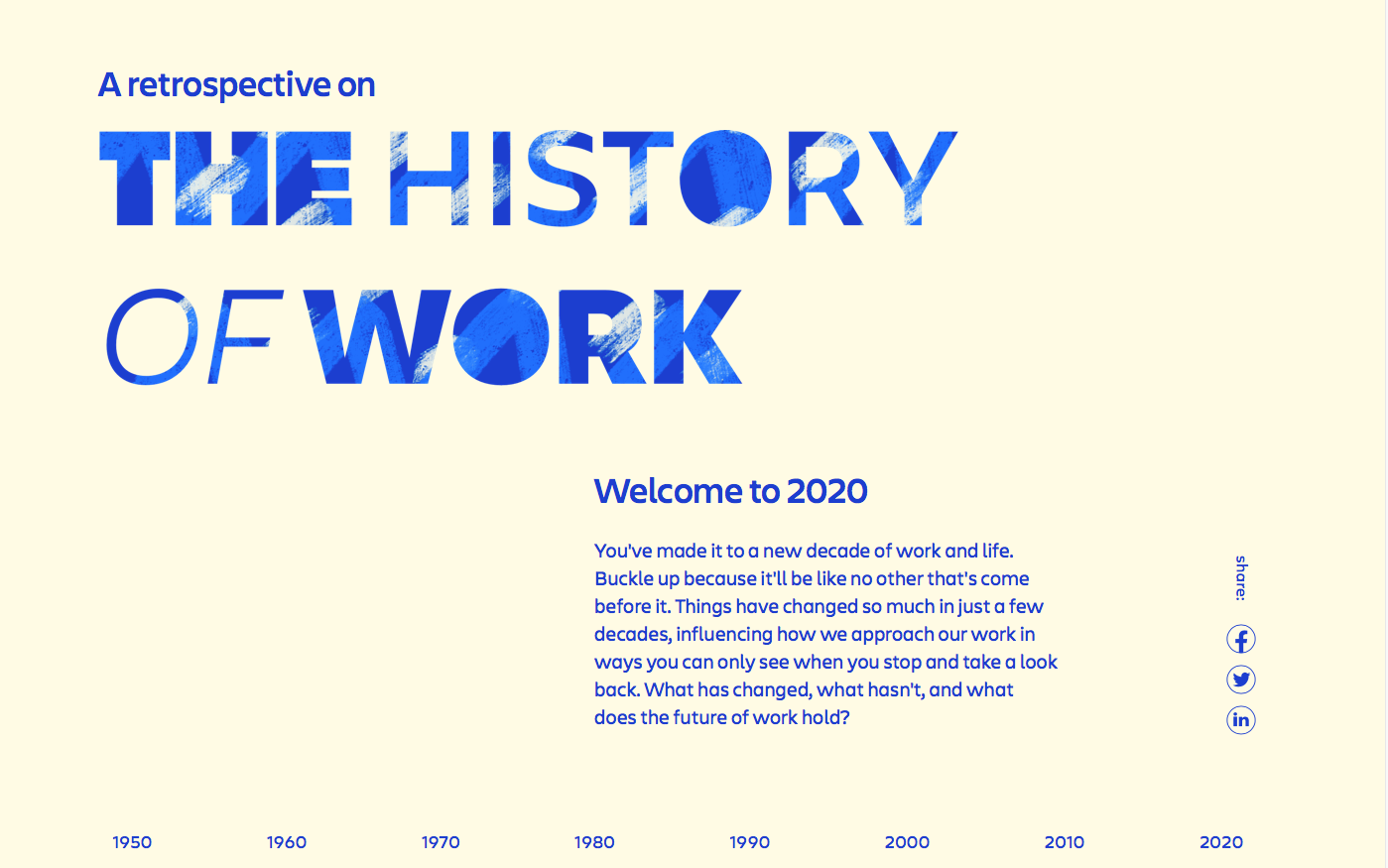
#26 The future of work looks like staying out of the office (ARS Technica / Kate Cox)
Roughly a quarter of us are already doing at least some work remotely. About 24 percent of US workers employed full-time did “some or all” of their work at home, according to the most recent federal data available. Even as some workplaces become increasingly distributed around the nation and the world, though, others are reversing course and doubling down on the corporate campus. So as we here at Ars look toward the future of work, we find ourselves wondering: employers and employees alike benefit from getting some folks out of cubeville, so what are so many businesses and managers afraid of?
#27 Five Challenges to Every Transformation (Inc., / Martin Zwilling)
#28 A New Era Of Emerging Technologies: Welcome To The Age Of Intelligence (CMO.com / Stephanie Overby)
“One in four CX leaders will get fired this year if they cannot improve CX to ensure revenue gains or cost savings. Indeed, more than half of consumers (54%) say CX at most companies needs some work, and a third (32%) will walk away from a brand they love after just one bad experience, according to PwC.
But here’s the good news: In the years ahead, CX leaders will have at their disposal an array of advanced technologies capable of transforming customer experiences. In fact, we are on the cusp of a new era of emerging technologies that Adobe CTO Abhay Parasnis calls the “intelligence wave,” and it’s bringing us machines that are learning how to see, hear, sense, and interpret the world around us. New, immersive technologies will create breakthrough experiences that extend into the physical world–beyond the screen of a mobile phone or lens of a pair of smart glasses.”
#29 Deep Dive: Digital-First Banking’s Challenges And Benefits (PYMNTS)

#30 New Research: Businesses face a 'digital ceiling' in their transformation progress (KM World / Joyce Wells)
“According to the research, companies know how to achieve moderate transformation success, with an 18% increase in companies progressing this year from the lowest tier of Watchers to the middle Explorer tier. However, Explorers struggled to move into the top Visionary cluster, with the top tier remaining the same, indicating a “digital ceiling” to transformation efforts.
The Visionary cluster remains unchanged despite companies reporting fewer barriers to digital transformation than last year. Human, rather than technological, barriers are now the most persistent, with the two of the top hurdles being the lack of talent or skills (34%) and a risk-averse corporate culture (35%).
“Companies hit the digital ceiling once they’ve mastered basic levels of digital competency,” said Kavanaugh. “Imagine moving from paper records to spreadsheets. Large companies have made that change. Now imagine shifting from the spreadsheet residing on one bookkeeper’s computer to a world where data is constantly updated and made available in a usable format to all relevant users. That’s a different and much tougher challenge, and it’s where companies bump up against this digital ceiling.”
#31 Scale digital innovation like a Champion (Accenture, David Abood)
#32 The Future of Retail - Augmented shopping: The quiet revolution (Deloitte / Cook, Kusumoto, Ohri)
“Imagine a future where your customer no longer shops by perusing a catalog of products, but instead they select a product type—be it a pair of pants, a car, or a dining room table—and then interactively dial and swipe their way to achieve the perfect dimensions, color, and style of whatever they are looking for. They could then try on, try out, or interact with it in any environment they might want—all from the comfort of their own homes. This vision is what augmented reality (AR) and 3D technology are turning into reality.
It’s a revolution unfolding less like a bang and more like a slow but powerful shift in tectonic plates. However, that isn’t cause for complacency. Today, more than 1 billion smartphones and tablet devices can deliver augmented experiences,2 and within the next year, 100 million consumers are expected to shop using AR either online or in-store.3 The consumer appetite is increasing—since 2018, the number of mobile AR users has nearly doubled, with usage and popularity driven largely through social media.4 In 2020, 46 percent of retailers plan to deploy augmented or virtual reality.
This is where the future is going, and in three years, if you don’t have AR in furniture, you’re going to be looked at as old-school. We’re not waiting. We want to be ahead of all that.”


